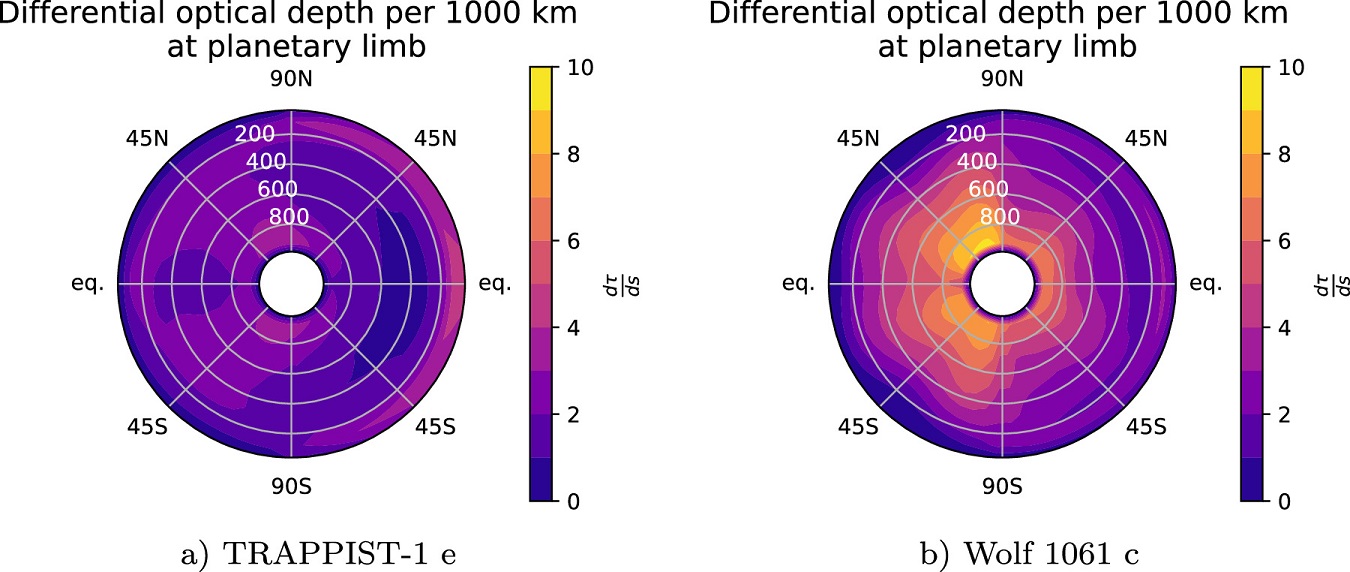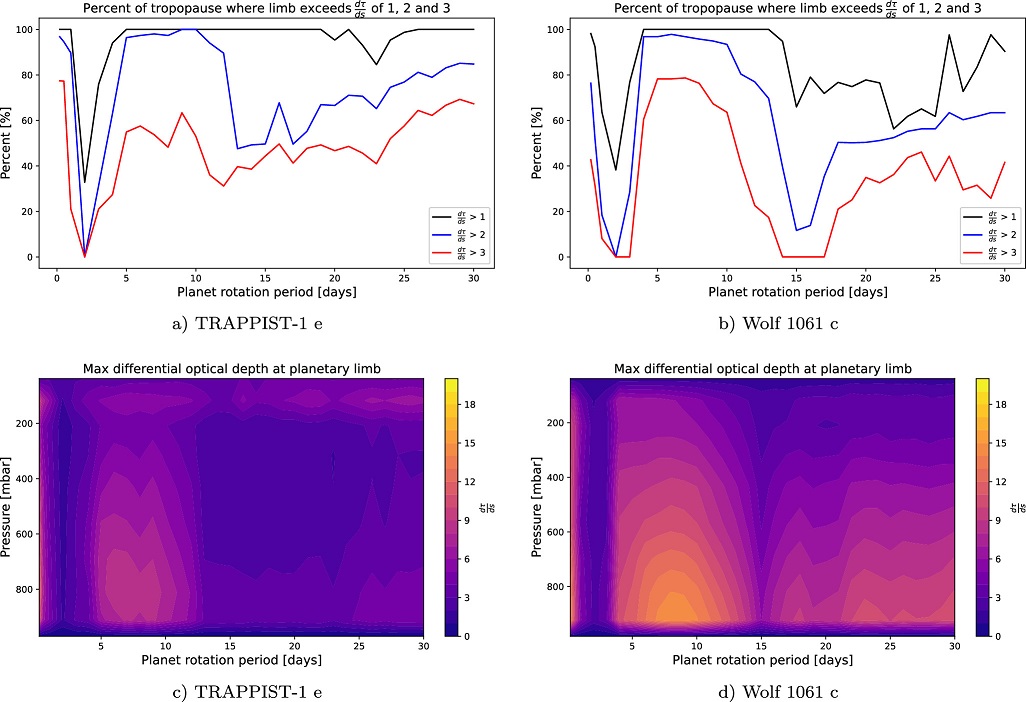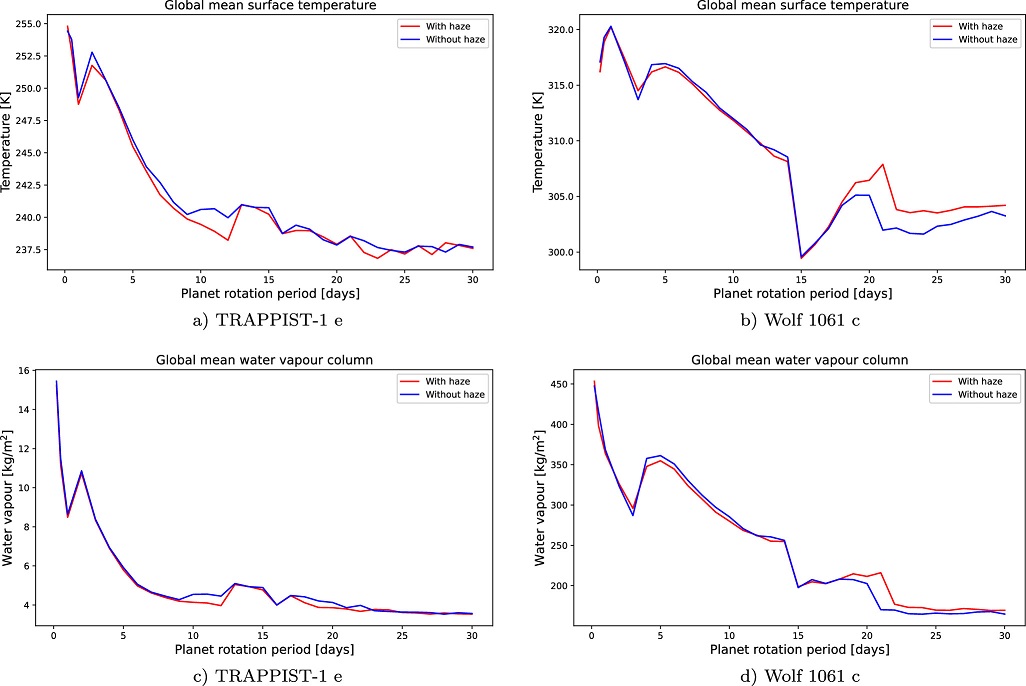Haze Optical Depth in Exoplanet Atmospheres Varies with Rotation Rate: Implications for Observations
- 1The Open University, School of Physical Sciences, United Kingdom of Great Britain – England, Scotland, Wales (maureen.cohen@open.ac.uk)
- 2School of GeoSciences, The University of Edinburgh, Edinburgh, United Kingdom of Great Britan - England, Scotland, Wales
- 3David A. Dunlap Department of Astronomy and Astrophysics, University of Toronto, Toronto, Canada
- 4School of Physics and Astronomy, University of Leicester, Leicester, United Kingdom of Great Britan - England, Scotland, Wales
Transmission spectroscopy is a leading method for characterising the atmospheric composition of exoplanets, but clouds and hazes in an observing target’s atmosphere frequently lead to muted or featureless spectra. Clouds and hazes also reciprocally interact with chemical species in the atmosphere and both affect and are affected by the planet’s climate, making modelling cloudy and hazy atmospheres extremely challenging. The complexity, sensitivity, and interdependence of these factors create a prohibitively large parameter space for exoplanet atmosphere modelling.
To meet this challenge, we present ExoPlaSim, an intermediate complexity 3-D climate model with radiatively active haze transport. ExoPlaSim is a fast, flexible, and portable model with a Python API that can ingest laboratory data on optical properties of hazes to simulate a range of hazy exoplanet atmospheres. We simulate a parameter space consisting of one Earth-sized and one super Earth-sized tidally locked terrestrial planet, using stellar spectra approximating TRAPPIST-1 and Wolf 1061, and testing 32 rotation periods for each planet ranging from 6 hours to 30 days. We used optical data published by He et al. 2024 [1] for laboratory-generated organic photochemical haze.
In agreement with past studies, we find that the simulated atmospheres fall into three main circulation regimes: banded for fast rotators, double jet for intermediate rotators, and single jet for slow rotators. The banded regime features two prograde mid-latitude jets and one retrograde equatorial jet and resembles Earth’s general circulation. The double jet regime develops two superrotating prograde mid-latitude jets and associated baroclinic Rossby waves, while the single jet regime has one superrotating equatorial jet and large nightside Rossby gyres. There is an additional transitional circulation regime between the banded and double jet regimes. Each circulation regime is associated with a distinct haze distribution which is non-uniform at the terminator region.
Figure 1 shows the haze optical depth at the planetary terminator when viewed from the host star. The super-Earth simulated (Wolf 1061 c) has a hazier terminator than the Earth-sized planet (TRAPPIST-1 e) due to build-up of haze particles in the “eyewall” of the nightside Rossby gyres. Both simulated planets show significant terminator asymmetry.

Figure 1: Optical depth at the planetary limb for two different planets with rotation periods of 18 days.
Figures 2 and 3 shows the full parameter space of rotation periods for both planets. Fast rotators developed uniformly hazy atmospheres, while the transitional space between 1-day and 3-day rotation periods resulted in very low haze amounts. Planets in the double jet regime developed hazier terminators because the gyres associated with the baroclinic Rossby waves, which tend to form on the terminator, collect haze particles and increase the terminator optical depth. Planets in the single jet regime had less hazy terminators because the gyres remained fully confined to the nightside.

Figure 2: Haze mass at the planetary limb as a function of rotation period, adjusted for planet size.

Figure 3: Optical depth at the planetary limb as a function of rotation period
Figure 4 shows the impact of the haze particles on the global mean surface temperature and global mean water vapour column for each simulation through comparison with identical simulations performed without haze. In our study, the hazes had very little impact on the planetary climate because they are primarily scattering, with low absorption. However, preliminary simulations with a different set of haze optical data show that this finding is very much not generalisable: different types of haze can have a profound impact on the climate and general circulation.

Figure 4: Global mean surface temperature and global mean water vapour column as a function of rotation period, for simulations with and without haze.
Our work shows that hazy exoplanet atmospheres likely do not have uniform haze distribution at the terminator. Data analysis methods such as transmission strings may be able to distinguish exoplanet circulation patterns based on these non-uniform aerosol distributions. In addition, we provide a tool for first-order testing of the sensitivity of exoplanet climates to different types of hazes.
References:
[1] He, C., Radke, M., Moran, S.E. et al. Optical properties of organic haze analogues in water-rich exoplanet atmospheres observable with JWST. Nat Astron 8, 182–192 (2024). https://doi.org/10.1038/s41550-023-02140-4
How to cite: Cohen, M., Palmer, P., Bollasina, M., Paradise, A., and Tiranti, P.: Haze Optical Depth in Exoplanet Atmospheres Varies with Rotation Rate: Implications for Observations, Europlanet Science Congress 2024, Berlin, Germany, 8–13 Sep 2024, EPSC2024-168, https://doi.org/10.5194/epsc2024-168, 2024.